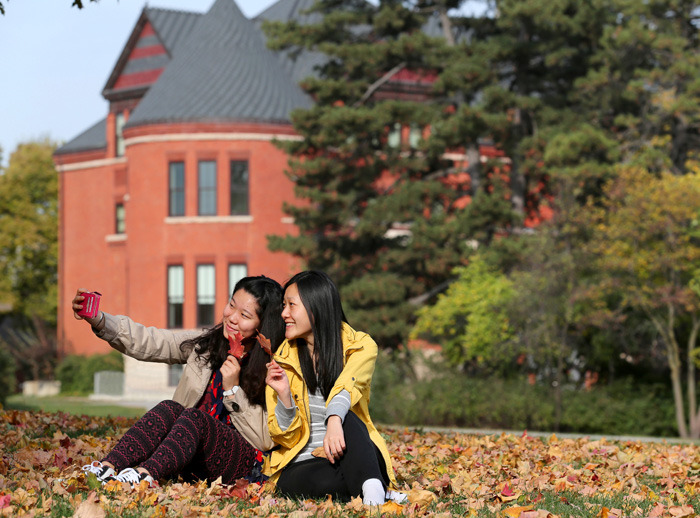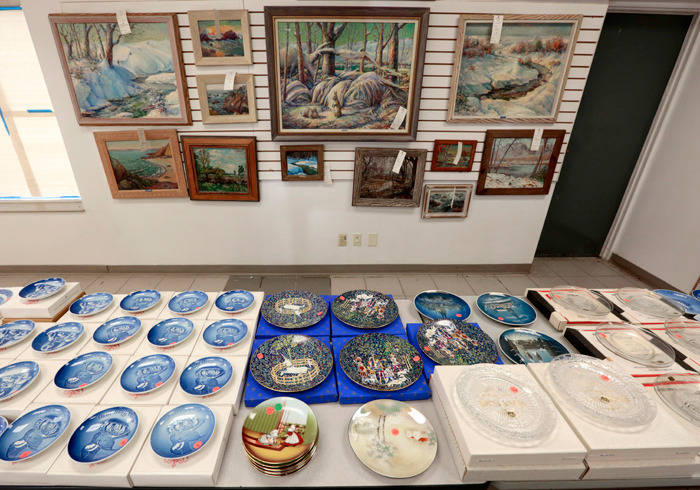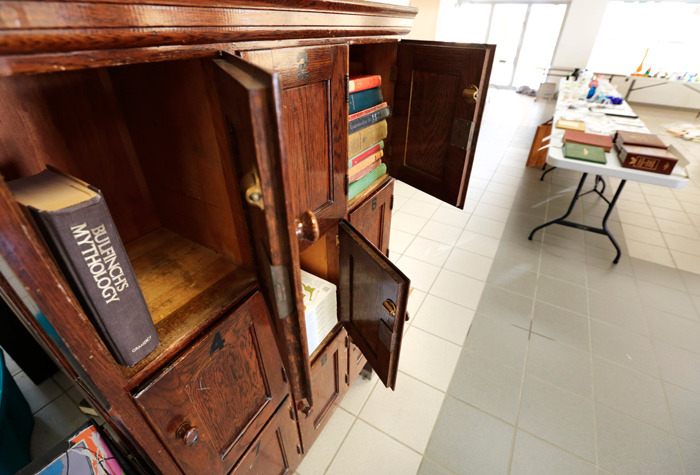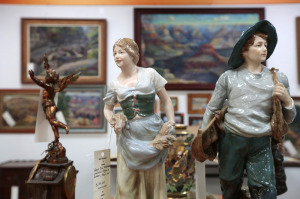Study break

Statistics graduate students Haiyang Zhang (left) and He Jiang take advantage of delightfully moderate weather Tuesday afternoon to shoot a smartphone selfie in fallen leaves on central campus. Photo by Christopher Gannon.
Faculty asked to assign intellectual property rights
Senate statement
President Rob Wallace shared language crafted in response to feedback heard during a student-organized open forum on Sept. 30 that raised concerns about diversity and inclusion on campus. The forum was sparked by incidents that took place during a Sept. 12 silent protest. Wallace said the response was written on behalf of faculty, based on comments received by the senate executive board.
In a presentation at the Oct. 20 Faculty Senate meeting, university counsel Paul Tanaka said faculty and research staff will be asked to assign intellectual property rights to the university to protect themselves and ISU from potential losses. He said work with industry, companies and collaborators must be protected in advance.
Tanaka cited a 2011 court case that cost Stanford University and its researchers significant losses in rights and royalties -- despite using federal funds for the disputed research.
"The Supreme Court said the university has an obligation to get an effective IP transfer agreement from [its] researchers, not just lead [principal investigators]," Tanaka said.
"The assignment will only cover IP rights the university has a right to claim under policy," Tanaka said. "All the scholarly works, copyrighted works that are traditionally owned by all of you -- like journal articles -- there is no impact on them. The only area of copyrights where this is going to be impacted are those copyrighted works that are subject to sponsorship, or require a significant contribution from the university -- that's generally going to be the area of software."
The processes are slowly changing on campus, including how the university deals with gold sheets (used for external grant applications) and disclosure agreements. The assignment language also is included in letters of intent for incoming faculty and staff.
Tanaka said the next step is to get current faculty and staff covered. He met with the senate's executive board to develop a plan for moving forward.
"The consensus is that we need to go out and ask current faculty and staff to sign these assignment agreements so we don't have the kind of risk that's out there," Tanaka said.
Other options might slow down the proposal process or create extra work for faculty and staff. Outside collaborators would be asked to sign agreements as well. Senior vice president and provost Jonathan Wickert said information about the assignment process will be communicated to all areas of campus.
New library dean
Senators met new library dean Beth McNeil, who presented an overview of upcoming projects and initiatives. Her highlights included:
- Planned programming and education about open access issues
- The "unique" support for ISU's digital repository
- A general purpose (active learning) classroom available next semester
- Student use of the library's mobile white boards
McNeil also outlined some of her priorities, including implementation of a new strategic plan, examining space needs and private fundraising. She also expressed her desire to continue "listening and learning" as she meets with individuals and groups throughout the university.
Other business
Senators cleared the docket with approval of three proposed items introduced last month, including:
- A lab-based, 15-credit cyber security minor program in the electrical and computer engineering department, intended for students in computer engineering, computer science, software engineering and management information systems
- An interdisciplinary, 15-credit urban studies minor program in the community and regional planning department, intended for students interested in urban history, urban design, neighborhood revitalization, economic development, social movements and global urbanization
- A name change for the art and design undergraduate program, to art and visual culture, which mirrors the department name (reorganized in 2012)
Senators continued discussion on proposed revisions to the guidelines for faculty personal responsibility statements (PRS) introduced last spring. Feedback on the recommendations are being accepted through Oct. 23, after which the executive board will submit a revised draft of recommendations to senators prior to their Nov. 10 meeting.
Art and antique sale to benefit University Museums

The sale includes many paintings by Iowa artist Orr C. Fisher and collector plates. All photos by Christopher Gannon.
A Civil War-era sword, antique microscope cabinet, collector plates and glass, first edition books by an 18th century British explorer, paintings and sketches by Iowa-born artist Orr C. Fisher and hundreds of owls are among items that will line the tables at Iowa State's Art and Antique Sale Oct. 29-Nov. 1.

An antique microscope cabinet is among several vintage pieces on the sale floor.
Proceeds of the four-day sale will be used to acquire, conserve and maintain works of art in the University Museums permanent collection.
The bulk of the sale items come from the Oregon home of Donna Howard, a 1952 home economics alumna, who bequeathed her estate to University Museums. Howard died in 2014. She was the niece of Orr C. Fisher, a prolific Depression-era painter and Iowa post office muralist who continued to create through the '60s, said museums director Lynette Pohlman.
Howard bought and sold many of her uncle's works, and more than 75 Fisher paintings and 200 drawings and cartoons from the estate will be part of the sale.
University Museums kept several of the Fisher paintings and drawings for its permanent collection. Another 25 paintings and 10 drawings were donated to museums, art centers and libraries in Corning, Greenfield, Winterset, Fisher's hometown of Mt. Ayr and to the State Historical Society of Iowa in Des Moines.

Almost anywhere you look, you'll see owls -- among the figurines, in sketches, on jewelry, even transfigured into a lamp.
The birds
Howard collected and traded owls in all kinds of artistic media -- ceramics, glass, silver, stone, paint and fiber. Owl fanciers will find the birds adorning such items as boxes, lamps, toothpick holders, sheet music and a walking cane.
Other sale items
Several pieces of furniture for sale come from Iowa State units and offices. These include:
- An antique microscope cabinet, a nine-door oak piece that's been sitting, pristine and dry, in the Physics Building basement for 24 years, according to central stores director Norm Hill
- A Baker dining room set
- An American empire-style, curved-glass curio cabinet, pier mirror, antique Bombé chest, vintage table and chairs

Royal Dux figurine, 1860-1915.
The sale also will include:
- Various kinds of glass -- Vaseline, emerald Croesus pattern, milk and cranberry
- Tea sets and china sets
- Books, postcards, records and stamps
- Lamps, figurines and containers
How much?
Most sale items range from $5 to $500. Among more expensive items are two first-edition book sets by James Cook. The explorer's hefty three-volume set, "A Voyage to the Pacific Ocean," 1784, is marked at $5,000, and the two-volume set, "A Voyage Towards the South Pole," 1777, at $2,800. An early 20th Century Rolleiflex Franke and Heidecke camera is priced at $1,000.
Sale time and place
The sale will take place at the new ISU Warehouse, 925 Airport Road, Ames, Iowa. (The warehouse is west of Munn Lumber Co. and north of the Ames Airport; follow the signs.) Hill invited football fans to drop by the sale prior to the Cyclones' homecoming game against Texas Oct. 31.
Sale hours are:
- Thursday, Oct. 29, 4-8 p.m.
- Friday, Oct. 30, 10 a.m.-4 p.m.
- Saturday, Oct. 31, 8 a.m.-1 p.m.
- Sunday, Nov. 1-4 p.m.
Work begins on the next strategic plan
In a little over eight months, Iowa State's next strategic plan goes into effect. The plan that will carry the university well into 2022 will retain Iowa State's current mission and vision and feature four overarching goals, specified by President Steven Leath.
Watch the Strategic Plan website for updates on planning progress.
It will come together under the direction of a small steering committee that will seek broad input from six subcommittees, the university community and external stakeholders.
"We have made tremendous progress under the current strategic plan that positions Iowa State to meet the challenges of the 21st century," Leath said. "Our next strategic plan will build off this progress by focusing on four comprehensive goals to advance our land-grant mission and raise ISU's profile and reputation, nationally and internationally.
"While the steering committee will lead the process, I encourage faculty, staff, and students to share their thoughts so that we can collectively build a strong, practical plan."
Steering committee
Steve Freeman, University Professor of agricultural and biosystems engineering, will lead the six-member steering committee that will oversee development of the plan. Other committee members are: senior vice president and provost Jonathan Wickert; senior vice president for student affairs Tom Hill; senior vice president for business and finance Warren Madden; associate vice president and chief of staff Miles Lackey; Larissa Holtmeyer Jones, president and CEO of the ISU Foundation; and vice president for diversity and inclusion Reginald Stewart, who joins Iowa State Dec. 1.
Subcommittee nominations sought
The steering committee seeks nominations for six subcommittees that will work on key components of the strategic plan.
"We're looking for volunteers or nominees to serve on these subcommittees," Freeman said. "If you have expertise or interest in serving on a subcommittee or would like to nominate people to subcommittees, send names through the online form by Oct. 30.
About the subcommittees
Following is more information on the subcommittees, most of which will be co-chaired by one faculty and one staff member.
The Student Experience subcomittee will focus on ensuring a successful student experience (academic, student life, co-curricular, etc.). Co-chairs are Steve Mickelson, chair of agricultural and bioystems engineering, and Rachel Wagner, associate director of residence life.
The Research Profile subcommittee will focus on enhancing the university’s research profile. Co-chairs are Beate Schmittmann, dean of Liberal Arts and Sciences, and Kan Wang, professor of agronomy.
The Economic Development and Service to Iowa subcommittee will focus on supporting state and regional economic development while serving all Iowans. Co-chairs are Mike Crum, vice president for economic development and business engagement, and Himar Hernandez, extension community development specialist.
The Campus Environment subcommittee will focus on ensuring a welcoming, safe, and inclusive campus environment. Co-chairs are Theressa Cooper, assistant dean for diversity, agricultural and life sciences, and Kenyatta Shamburger, director of multicultural student affairs
The Infrastructure Enablers subcommittee will focus on aspects of the campus infrastructure that cut across the university (for example, facilities, computer networks, environmental health and safety, transportation). Co-chairs are Amanda Fales-Williams, associate professor of veterinary pathology, and Robert Currie, director of facilities services.
The Additional Creative Opportunities subcommittee will focus on capturing creative, out-of-box ideas broadly related to the other five subcommittees. This subcommittee will be looking for ideas that might be missed in the more structured processes of the other strategic planning subcommittees. Co-chairs are Marlene Strathe, director of the school of education, and Keith Robinder, associate dean of students
Mission, vision remains the same
Leath stipulated that the current university mission and vision (shown below) remain the same.
- Mission: Create, share and apply knowledge to make Iowa and the world a better place.
- Vision: Iowa State will lead the world in advancing the land-grant ideals of putting science, technology and human creativity to work.
Leath added that it's important, as the university advances and circumstances change, to routinely adjust priorities and processes to accomplish this mission and vision.
Overarching goals
Leath asked the steering committee to feature four overarching goals in the plan, along with strong action steps to achieve them. The goals are to:
- Ensure a successful experience for students
- Enhance the university's research profile
- Support state and regional economic development while serving all Iowans
- Ensure a welcoming, safe and inclusive campus environment
Coordination with regents, foundation
Leath delayed development of the next plan so that it could be coordinated and closely aligned with the state Board of Regents and ISU Foundation strategic planning processes. Freeman will coordinate across the three groups, which will engage in simultaneous strategic planning for the first time.
Timeline
The first draft of the strategic plan should be ready for public review by mid-spring semester 2016, Leath said, "so there is plenty of time for public comment and input between spring break and the end of the semester." Once input is gathered, the plan will be finalized and submitted for presidential approval by June 1, 2016.
The new plan will span fiscal years 2017 through 2022 (July 1, 2016-June 30, 2022).
Regents receive recommendations for two academics-related TIER cases
Iowa's three regent universities need to set more aggressive growth goals for their distance learning programs -- 10 to 15 percent annual growth instead of the current 3 -- said consultants assessing the issue as part of the state Board of Regents' TIER (Transparent, Inclusive Efficiency Review) effort. Alceste Pappas and James McCarthy of the Pappas Consulting Group presented preliminary recommendations Wednesday to the board on the two academic business cases the firm was hired to look at: enrollment management (formerly identified as time to degree) and e-learning (formerly distance learning).
The board meeting continues Thursday in Iowa City. Audio of public portions of the meeting will be streamed live beginning around 10:15 a.m.
McCarthy praised what he called the "Iowa Regents' Model" of distance education and said it should be preserved and supported. That model focuses on:
- Linking online offerings to existing strong face-to-face programs
- Using fulltime faculty as instructors for both
- Ensuring the quality of the two is comparable
Learn more
These Pappas Consulting documents are on the state Board of Regents' website:
Opportunities for growth in e-learning exist, he said, in summer school offerings, general education courses with high enrollments and professional graduate programs in high demand areas. McCarthy also encouraged the three universities to collaborate more on e-learning "to insure maximum program reach with minimum duplication." This could include a shared portal that offered one-stop access to distance courses offered at all three universities.
McCarthy said the Pappas team tried to shape its recommendations "whenever possible, on things being done at at least one school.
"They're going on somewhere, maybe not universally," he said. "A lot of inspiration comes from people already doing it."
Enrollment management business case
The Pappas Group defined enrollment management as costs associated with scholarships and financial aid, orientation and first-year success programs, academic advising, registration, counseling services and career services. The group compared these costs to recruitment and admissions costs and found that the regent universities spend more to admit a freshman student than it costs to provide enrollment management services (assessed on a per capita basis). Rising freshman admission numbers over the last 10 years have been countered by declining percentages of admitted students who actually enroll; what Pappas termed "the yield."
Pappas encouraged board members to diminish competition for the same students among the three universities and focus instead on how each fares among its self-selected peer group. She noted that all three schools rank low among their peers in student yield, enrolled students' ACT scores, four-year graduation rate and state-funded financial aid available for resident students. (An approximately $60 million state grant program is reserved for resident students at private or for-profit colleges and universities.)
She recommended that the universities "beef up" student support services to boost retention rates as a revenue strategy.
Pappas also questioned the use of the Regents Admission Index, a formula used to grant admission to any of the three regent schools for high school graduates. It's alright for the three campuses to have different entrance thresholds, she noted.
"There are questions of access and selectivity that each of you needs to address," she said, especially in the context of peer group comparisons.
Other enrollment management recommendations included:
- Each university should develop a strategic enrollment management plan, including performance metrics that suit its mission and peer group.
- Make strategic investments in enrollment management programs at Iowa State and the University of Iowa. The University of Northern Iowa offers a broad range of support programs and invests more (per undergraduate student) than the other two schools.
- Advocate for a state-funded, need-based aid program and merit scholarships for Iowa residents attending the regent universities.
What's next
In addition to the lengthy report the Pappas team shared with board members, the consultants next week will send a data set and work papers to the three universities and the board office to assist with implementation decisions and planning.
Associate vice president and chief of staff Miles Lackey, who also serves as the regents' liaison to the Pappas consultants, said board members have about a month to review the Pappas findings and recommendations. During a not-yet-scheduled November meeting, the board will decide which recommendations to implement.
Faculty work week
Also at Wednesday's meeting, members of the education and student affairs committee received an oral summary of last spring's faculty activity survey, a self-report of work responsibilities on which faculty spend their time. At Iowa State, 84 percent of faculty participated in the biennial survey. The survey they completed was the same one used for the first time in spring 2013, which asks for more detailed information to better capture the variety of faculty work activities.
While there are fluctuations among the faculty groups, ISU faculty, on average, worked 55.7 hours per week, down from averages of 57.2 hours and 58.0 hours, in spring 2013 and 2011, respectively.
Iowa State FT faculty activity: Average hours per week (Spring 2015)
|
Work activity |
Tenured, |
Non |
Clinician |
Chair, |
|
Student instruction (includes advising, research mentoring) |
23.69 |
34.88 |
18.36 |
11.90 |
|
Research/creative work |
21.00 |
8.36 |
12.98 |
9.03 |
|
Clinical work |
0.57 |
1.83 |
16.85 |
0.06 |
|
Community engagement/outreach |
2.65 |
1.84 |
5.62 |
2.66 |
|
Professional development |
0.88 |
0.80 |
1.89 |
0.65 |
|
Administration/service |
8.02 |
3.65 |
3.21 |
36.16 |
|
Total hours |
56.81 |
51.36 |
58.91 |
60.46 |
Compared to spring 2013, tenured and tenure-track faculty delivered a smaller percentage of the total student credit hours (SCH) last spring, about 6 percentage points fewer both overall and for undergraduate courses only. Most of that decline was picked up by non tenure-track faculty. However, total student credit hours taught increased about 14 percent from 2013 to 2015 and increased for every instructor group.
Iowa State FT faculty: Distribution of student credit hours (Spring 2015)
|
Group |
Undergraduate |
Graduate |
Professional |
All student credit hours |
|
Tenured faculty |
36% |
71% |
69% |
40% |
|
Tenure-track faculty |
12% |
19% |
8% |
12% |
|
Non tenure-track faculty |
38% |
10% |
23% |
36% |
|
Graduate assistants |
14% |
0% |
0% |
12% |
Income tax break proposal
Graduate and professional student governments at the three regent universities outlined a proposal to keep more of their constituents in the state following graduation: A 50 percent income tax break, for five years, for regent school-educated graduate and professional students who take jobs in Iowa. The tax break would jump to 75 percent for those who live and work in rural Iowa.
Joshua Schoenfeld, a medical student at the University of Iowa, said the organizing group will continue to seek survey responses from graduate and professional students at the three universities through February, with the hope of achieving a 20 percent response rate. Currently, they have about a 10 percent response rate. The survey asks about interest in a tax break and its potential impact on their job-seeking choices. He said the group would ask the board to support the proposal.
Regent Katie Mulholland, who chairs the board's academic and student affairs committee, asked to receive a final copy of the group's proposal and report when it's completed sometime late next spring.
The group sent its proposal to Gov. Terry Branstad earlier this month for consideration as future state budgets are developed.
Easy fix for wrong numbers
Change your info
- Sign on to AccessPlus
- Select employee tab
- Select "address info" (top left)
- Complete changes and submit
- Exit AccessPlus
New employees sometimes get temporary phone numbers. Current employees change jobs. Departments move and units merge. These are some of the ways inaccuracies creep into the online directory. It can take a while for university systems to catch up to some phone or address changes.
There's an easier, faster way. Through AccessPlus, faculty and staff can quickly update their phone numbers and physical addresses for both the office and home. They also can withhold home addresses from appearing in the directory. Just follow the instructions in the box.
Changes on the directory's department listings can be made throughout the year, with a little help from information technology services staff. Send corrections to teleinfo@iastate.edu.
